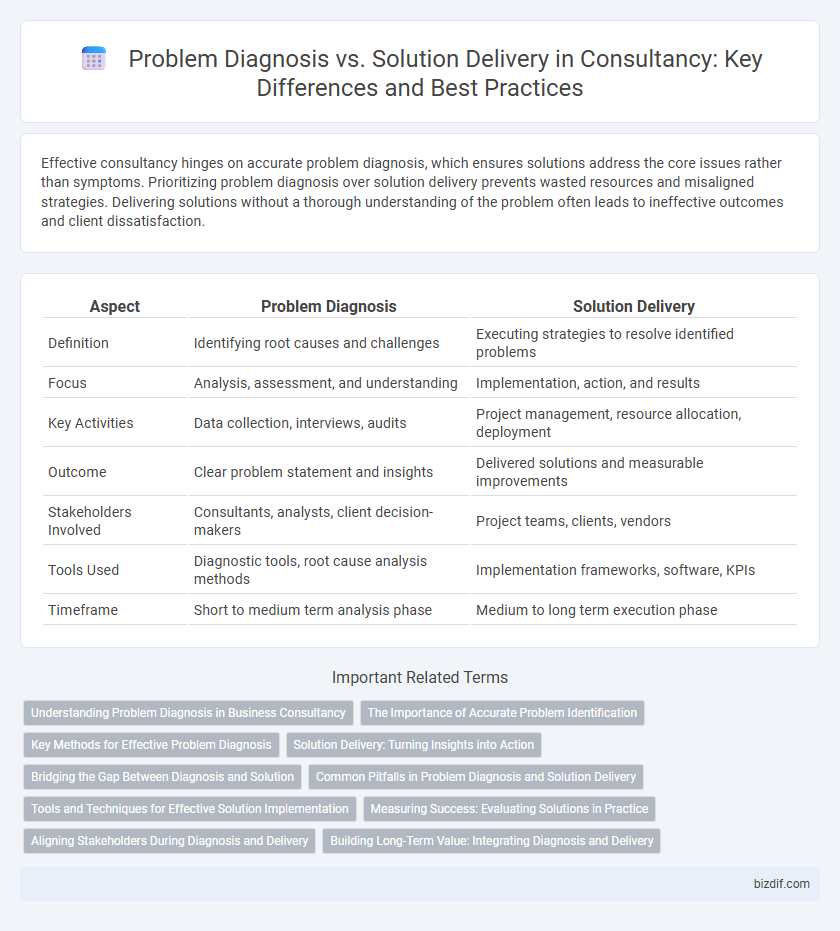Effective consultancy hinges on accurate problem diagnosis, which ensures solutions address the core issues rather than symptoms. Prioritizing problem diagnosis over solution delivery prevents wasted resources and misaligned strategies. Delivering solutions without a thorough understanding of the problem often leads to ineffective outcomes and client dissatisfaction.
Table of Comparison
| Aspect | Problem Diagnosis | Solution Delivery |
|---|---|---|
| Definition | Identifying root causes and challenges | Executing strategies to resolve identified problems |
| Focus | Analysis, assessment, and understanding | Implementation, action, and results |
| Key Activities | Data collection, interviews, audits | Project management, resource allocation, deployment |
| Outcome | Clear problem statement and insights | Delivered solutions and measurable improvements |
| Stakeholders Involved | Consultants, analysts, client decision-makers | Project teams, clients, vendors |
| Tools Used | Diagnostic tools, root cause analysis methods | Implementation frameworks, software, KPIs |
| Timeframe | Short to medium term analysis phase | Medium to long term execution phase |
Understanding Problem Diagnosis in Business Consultancy
Problem diagnosis in business consultancy involves systematically identifying root causes of organizational challenges by employing data analysis, stakeholder interviews, and process evaluations. Accurate problem diagnosis ensures targeted strategies and effective resource allocation, reducing risks of misinformed decisions. Emphasizing comprehensive diagnosis enhances long-term business performance by addressing underlying issues rather than superficial symptoms.
The Importance of Accurate Problem Identification
Accurate problem identification in consultancy enables targeted solution delivery that addresses root causes rather than symptoms, minimizing resource waste and maximizing client value. Diagnostic precision relies on comprehensive data analysis, stakeholder input, and methodical assessment to uncover underlying issues obscured by surface-level challenges. This focused approach enhances solution effectiveness, accelerates implementation, and ensures sustainable business impact for clients.
Key Methods for Effective Problem Diagnosis
Effective problem diagnosis in consultancy relies on structured methods such as root cause analysis, stakeholder interviews, and data-driven assessments to identify underlying issues accurately. Utilizing tools like the 5 Whys technique and Fishbone diagrams enhances clarity and promotes comprehensive understanding of complex challenges. Prioritizing these diagnostic approaches ensures tailored, impactful solutions aligned with client objectives.
Solution Delivery: Turning Insights into Action
Solution delivery in consultancy transforms diagnostic insights into actionable strategies that drive measurable business outcomes. By leveraging data-driven analysis and tailored implementation plans, consultants ensure solutions align with client objectives and organizational capabilities. Effective solution delivery bridges the gap between identifying challenges and executing sustainable improvements, maximizing return on investment.
Bridging the Gap Between Diagnosis and Solution
Effective consultancy hinges on bridging the gap between problem diagnosis and solution delivery by aligning analytical insights with actionable strategies. Integrating comprehensive root cause analysis tools ensures precise identification of challenges while facilitating tailored solution frameworks that address specific client needs. Leveraging collaborative workshops accelerates knowledge transfer and commitment, fostering seamless transition from diagnosis to implementation for measurable business impact.
Common Pitfalls in Problem Diagnosis and Solution Delivery
Common pitfalls in problem diagnosis include relying on superficial data, neglecting root cause analysis, and misinterpreting stakeholder inputs, which often lead to incomplete understanding of issues. In solution delivery, frequent errors involve insufficient alignment with business objectives, inadequate change management, and lack of iterative feedback loops, causing implementation failures. Effective consultancy requires rigorous problem diagnosis paired with adaptive solution delivery to avoid these pitfalls and ensure sustainable outcomes.
Tools and Techniques for Effective Solution Implementation
Effective solution implementation in consultancy relies on diagnostic tools such as root cause analysis, SWOT analysis, and stakeholder interviews to accurately identify problems. Techniques like Agile project management, change management frameworks, and pilot testing ensure solutions are delivered efficiently and adapted to client needs. Leveraging data analytics platforms and collaborative software enhances real-time monitoring and iterative improvements during the delivery process.
Measuring Success: Evaluating Solutions in Practice
Measuring success in consultancy requires a clear distinction between problem diagnosis and solution delivery, as accurate diagnosis defines the criteria for effective solutions. Quantitative metrics such as ROI, employee productivity improvements, and customer satisfaction scores, alongside qualitative feedback, offer a comprehensive evaluation of implemented solutions. Continuous monitoring and adaptive adjustments ensure that solutions remain aligned with business objectives and deliver sustained value.
Aligning Stakeholders During Diagnosis and Delivery
Aligning stakeholders during problem diagnosis involves fostering open communication to accurately identify underlying issues and ensure consensus on priorities. During solution delivery, maintaining stakeholder engagement guarantees transparency, manages expectations, and facilitates smooth implementation. Effective stakeholder alignment mitigates risks and accelerates project success in consultancy engagements.
Building Long-Term Value: Integrating Diagnosis and Delivery
Problem diagnosis identifies underlying client challenges using data analytics, stakeholder interviews, and process mapping, ensuring a precise understanding of issues impacting long-term performance. Solution delivery implements tailored strategies and change management plans that align with the organization's goals, fostering sustainable improvements and measurable outcomes. Integrating diagnosis with delivery creates continuous feedback loops, enhancing adaptability and driving enduring business value in consultancy engagements.
Problem diagnosis vs Solution delivery Infographic

 bizdif.com
bizdif.com